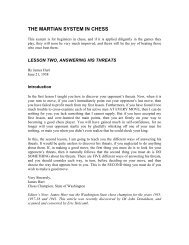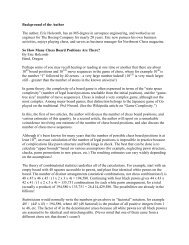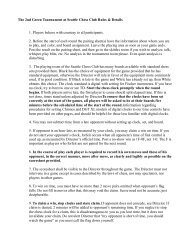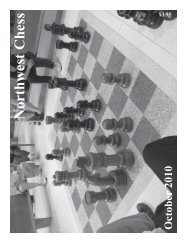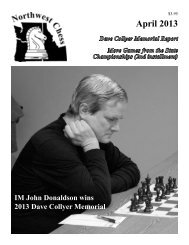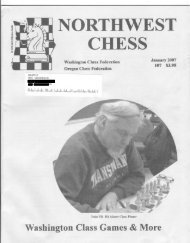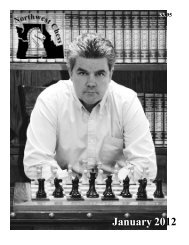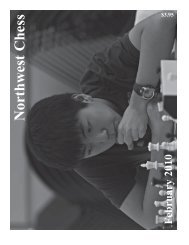You also want an ePaper? Increase the reach of your titles
YUMPU automatically turns print PDFs into web optimized ePapers that Google loves.
The Ever-<br />
Changing Map<br />
Student: Pete, can we talk about<br />
planning some more?<br />
Master: Sure, what’s on your mind.<br />
Student: Well, we’ve talked about a<br />
master figuring out what he wants to do<br />
before he worries about how to do it. And<br />
you’ve shown me a couple of games that<br />
illustrate where the “what?” comes from. In<br />
Wells-Totsky, we saw strategy following<br />
structure: Grandmaster Wells exchanged<br />
pieces in such a way that his remaining<br />
pieces coordinated smoothly with the pawn<br />
structure, while leaving his opponent’s<br />
pieces badly hampered by that same<br />
structure. Then in Lehmann-Mueller we saw<br />
structure following strategy: Black’s<br />
development was delayed, and his king was<br />
in the center, and so Hans Lehmann blasted<br />
open the center to create attacking lines. In<br />
other words, he created the structure he<br />
needed for his strategy to work.<br />
Master: That’s a good summary. Go on.<br />
Student: Well, I’ve been trying to do that<br />
in my own games. I figure out what I want<br />
to do, and then work out a way to make that<br />
happen. But then...my opponent gets in the<br />
way.<br />
Master: (chuckling) They do have a way<br />
of doing that, don’t they? The two games<br />
you mentioned are great illustrations of the<br />
basic theme, but neither is typical of the way<br />
master games normally develop.<br />
Student: They’re not?<br />
Master: No, because in each of them,<br />
one single strategic theme ran through the<br />
entire game—or at least the part of the game<br />
with which we were concerned. I started<br />
with those games so that you’d have a clear<br />
idea of the planning process. However, as<br />
you aptly point out, one’s opponent has this<br />
nasty habit of not playing along. That can<br />
happen in either of two ways: he blocks your<br />
progress, or he does something that actually<br />
changes the map.<br />
Student: Oh that’s an interesting way<br />
to think about it.<br />
Master: The image isn’t mine, though<br />
it sure makes sense to me. Garry Kasparov<br />
once observed that planning in chess is like<br />
getting directions off a map that keeps<br />
changing! That’s why most planning is<br />
Transitions<br />
by Pete Prochaska<br />
short-term: the map changes too quickly—<br />
and too significantly—for long term plans<br />
to reach fruition, except in very broad terms.<br />
Student: What do you mean?<br />
Master: Well, as an analogy, think about<br />
the situation in Europe in early 1944. What<br />
was the Allied strategy for winning World<br />
War II?<br />
Student: To invade Europe. Oh, I see<br />
what you mean: it didn’t take any great<br />
strategic acumen to see that. There really<br />
wasn’t anything else they could do. The<br />
strategic issues that Ike’s staff had to deal<br />
with were the operational possibilities for<br />
implementing that general strategy.<br />
Master: Exactly. The corollary in chess<br />
is this: there are only two basic winning<br />
strategies: to mate your opponent’s king with<br />
a direct attack—what we call “Kill The<br />
King,” or win some material, promote a<br />
pawn, and then mate your opponent’s king—<br />
what we call “Win In The End.” The<br />
difficulty, of course, is that our opponent is<br />
not only working to stop us, he’s also<br />
actively attempting to do the same thing to<br />
us. So what we end up with is a constantly<br />
shifting battlefield—which, in turn, points<br />
to the absolute necessity of adapting our<br />
plans as the map of that battlefield changes.<br />
Student: That makes sense, but I do have<br />
a question.<br />
Master: Surprise, surprise…<br />
Student: (smiling) In another recent<br />
conversation, you shared a story about<br />
Capablanca. As I remember it, several<br />
players were analyzing a complex endgame,<br />
and not finding a convincing way for White<br />
to realize his apparently significant<br />
advantage. Then Capa wandered by, and<br />
since he was generally regarded as the<br />
greatest endgame player in the world, they<br />
asked him. He looked at the position for a<br />
few moments, and then pushed all the pieces<br />
off the board. Capablanca then proceeded<br />
to set up a position and told the players that<br />
was what White needed to achieve. Once<br />
they saw the target position, they understood<br />
how to win the game. Then it was just a<br />
matter of reaching that position, which they<br />
were able to do without too much trouble.<br />
That seems like a great example of longterm<br />
planning.<br />
How does that<br />
fit with your<br />
ever-changing<br />
map?<br />
Master:<br />
It’s a great<br />
story, and an<br />
excellent question. There are several things<br />
to keep in mind. To start with, we don’t know<br />
how far removed Capa’s “target position”<br />
was from the actual position about which<br />
he was asked. If it was only a matter of a<br />
half-dozen moves, that’s a quite reasonable<br />
planning horizon. If it was more than that, it<br />
still would have been something to aim for,<br />
though the probability that target position<br />
would need to be revised increases<br />
exponentially.<br />
It’s also true that endgame thinking is<br />
often more schematic—based around<br />
achieving key positions—than middlegame<br />
thinking can afford to be. That’s because<br />
endgame positions are often more stable than<br />
most middlegame positions. Finally, we also<br />
know that White was attempting to convert<br />
an advantage, so Black’s ability to<br />
significantly change the position and<br />
direction of play—to alter the map, as it<br />
were—might have been quite limited.<br />
Student: So a player might have a broad<br />
strategy—attack the king in the center, for<br />
example—but the operational plans are<br />
normally relatively short-term.<br />
Master: Indeed. That’s the only way to<br />
allow for the fact that we’re getting<br />
directions from a battlemap that’s in constant<br />
flux. It seems to me the basic planning<br />
question is “Where do I want my pieces over<br />
the next 5-6 moves.”<br />
However, that’s enough general theory<br />
for now. Let’s look at a practical example,<br />
involving two of the strongest players in<br />
chess history, Mikhail Botvinnik and Paul<br />
Keres, played during the 1952 USSR<br />
Championship in Moscow. The reigning<br />
World Champion, Botvinnik, has White. Not<br />
surprisingly, he heads for an Exchange<br />
Queen’s Gambit, one of his favorite<br />
variations: 1. d4 Nf6 2. c4 e6 3. Nc3 d5 4.<br />
cxd5 exd5 5. Bg5 Be7 6. e3 0–0 7. Bd3<br />
Nbd7 8. Qc2 Re8 9. Nge2 Nf8.<br />
Page 16 <strong>Northwest</strong> <strong>Chess</strong> August 2009



